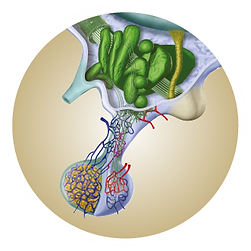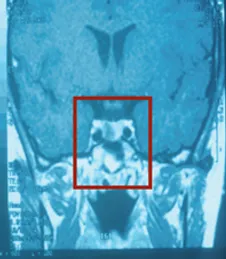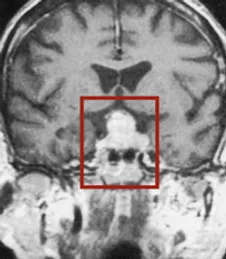
Prolactinoma Menu

What is a Prolactinoma?
STIMULATES THE PRODUCTION OF BREAST MILK DURING PREGNANCY
The pituitary is a tiny gland situated at the base of the brain behind the nose and below the optic nerves. The pituitary makes hormones that control the thyroid, ovaries, testes, and adrenal glands. Another hormone made by the pituitary is PROLACTIN, which stimulates the production of breast milk during pregnancy and breastfeeding.
Prolactin secretion is controlled by a compound called dopamine, which is made in the brain. In women, normal prolactin levels are typically less than 25 ng/ml, and in men, less than 17 ng/ml. When prolactin levels are elevated in the blood, the condition is referred to as HYPERPROLACTINEMIA.
Hyper - meaning ‘increased’; Prolactin referring to the hormone; -emia meaning ‘in the blood’
Blood prolactin levels are normally elevated during pregnancy and breastfeeding and may also be increased with some medications, kidney failure, and chest trauma.
A prolactinoma is an abnormal growth, or tumor, on the pituitary gland. The tumor causes the pituitary to produce too much prolactin, leading to hyperprolactinemia. A prolactinoma is almost always benign, meaning it is not a cancer. About 1 in 10,000 people will develop a prolactinoma for which a clear cause is not known. Prolactinomas occur in both sexes but are more common in women. The tumors are seldom seen in children and are rarely passed from parents to their children. Prolactinomas are usually small and rarely grow, but some (as discussed below) can become very large.

What are the Symptoms of Prolactinoma?
A LARGE TUMOR MAY CAUSE PRESSURE ON THE OPTIC NERVES
Prolactinomas come to attention because of the effect of elevated prolactin on the reproductive system and/or the size of the tumor. A very large tumor may cause pressure on the optic nerves or nearby brain tissue, leading to headaches and/or vision problems.
Symptoms in Women
High levels of prolactin made by the tumor interfere with the ability of the ovaries to make estrogen. When estrogen levels are low, women will have absent or irregular menstrual periods, low sex drive, vaginal dryness, and difficulty achieving a pregnancy. Because of the effect of elevated prolactin levels on breast tissue, women who are not pregnant or breastfeeding frequently experience a milky breast discharge. This condition is called GALACTORRHEA.
TABLE 1. MOST COMMON PRESENTING SYMPTOMS
| WOMEN |
|---|
| Absent or Irregular Periods |
| Infertility |
| Low Sex Drive |
| Vaginal Dryness |
| Difficulty Achieving Pregnancy |
| Galactorrhea |
| MEN |
|---|
| Headaches/Vision Problems |
| Low Sex Drive |
| Erectile Dysfunction |
| Infertility (Rare) |
| Galactorrhea (Rare) |
Women with prolactinomas will rarely have headaches, visual symptoms, or other complaints related to tumor size because most prolactinomas in women are small and often do not progressively increase in size.
Symptoms in Men
Even slight elevations in prolactin levels from very small pituitary tumors can lead to a decrease in sex drive and cause erectile dysfunction. Larger tumors in men are associated with very high levels of prolactin, which almost always causes sexual dysfunction. Breast discharge (galactorrhea) can occur in men but is much less common than in women.
Men with prolactinomas may also seek medical attention because of headaches or vision problems due to large tumors, which can cause pressure on the optic nerves. Because of the size of these tumors, prolactin levels are often very high. The high levels of prolactin can limit the ability of the testes to make testosterone and can infrequently cause infertility.
Because of the low estrogen and testosterone levels that may occur with elevated prolactin, some men and women also develop low bone density; however, fractures and osteoporosis are uncommon.
Since prolactin inhibits the ability of the testes to produce testosterone, men with prolactinomas often present to their doctor with decreased sex drive and/or erectile dysfunction.

What else can cause elevated prolactin levels?
STRESS, PREGNANCY, KIDNEY DISEASE, CHEST TRAUMA, ETC.
There are a few conditions other than prolactinomas that may be associated with hyperprolactinemia. As prolactin is regulated by dopamine, medications that interfere with this substance in the brain can cause elevated prolactin levels.
Drugs prescribed for psychiatric and gastrointestinal disorders may raise prolactin levels to greater than 200 ng/ ml. Other drugs that can cause mild elevations of prolactin levels include estrogens and verapamil, a drug used to treat high blood pressure.
An underactive thyroid or inadequate thyroid hormone replacement can also raise prolactin levels, as can kidney disease, pregnancy, stress, and chest trauma.
Causes of Hyperprolactinemia
- Prolactinomas
- Medications (phenothiazines, metoclopramide, risperidone, selective serotonin reuptake inhibitors, estrogens, verapamil)
- Stress
- Pregnancy
- Hypothyroidism
- Kidney disease
- Chest Trauma
Most patients with medication-induced hyperprolactinemia will have prolactin levels between 25 and 100 ng/ml (rarely up to 250 ng/ml). If an elevated prolactin level is due to a medication, the level will usually return to normal 3–4 days after the drug is stopped. It is not possible to determine the cause of an elevated prolactin from the blood level alone. Even if you have a high prolactin level caused by a medication, do not stop any of your medications without first consulting your doctor.

What Testing Will Be Necessary?
SUSPECTED IN WOMEN WHO HAVE ABSENT OR IRREGULAR MENSTRUAL PERIODS
Hyperprolactinemia is suspected in women who have absent or irregular menstrual periods, abnormal breast discharge, or fertility issues. In men, an elevated prolactin level is suspected in the presence of erectile dysfunction, infertility, headaches, or vision problems.
The first step in the evaluation is to draw a blood sample to determine the prolactin level. The sample can be drawn at any time of day, and a normal level is less than 25 ng/ml in women and less than 17 ng/ml in men. One sample is usually adequate to make the diagnosis. If the prolactin level is just barely elevated, the sample may need to be repeated because even the stress and discomfort of the blood draw itself can affect the results. During the evaluation, your doctor will look for other conditions that could raise prolactin levels and may draw additional blood samples to test other hormone levels.
If your prolactin level is elevated and all other tests are normal, the next step is to view the pituitary gland by using a magnetic resonance imaging (MRI) scan with and without contrast dye. The MRI scan will show if there is a tumor on the pituitary, its size, and whether the tumor has affected the optic nerves or other areas around the pituitary.
The pictures below compare the MRI scans of a microadenoma in a young woman and a macroadenoma in an older man.

31-YEAR-OLD WOMAN
A 31-year-old woman presented with absent menstrual periods, abnormal breast discharge, and wanted to get pregnant. Her prolactin level was 125 ng/ml.

60-YEAR-OLD MAN
A 60-year-old man presented with headaches and a low sex drive. His prolactin level was 6,000 ng/ml.
Doctors use different terms to describe the tumor based on its size. Prolactinomas are called MICROADENOMAS if they are smaller than 10 mm (about ½ inch) and MACROADENOMAS if they are 10 mm or larger. Most prolactinomas in women are microadenomas. Prolactinomas in men are more likely to be macroadenomas, although microadenomas are also seen. The large tumors can be associated with extremely high prolactin levels (sometimes greater than 1000 ng/ml). Macroadenomas can push on the optic nerves, and men or women with large tumors may need a special eye examination called a formal visual field assessment as part of their initial evaluation. The pictures below compare the MRI scans of a microadenoma in a young woman and a macroadenoma in an older man.

How are Prolactinomas Treated?
PRESCRIPTION MEDICATION FOR DRUGS CALLED DOPAMINE AGONISTS
The treatment of choice for all patients with prolactinomas is a prescription medication for drugs called dopamine agonists. These drugs work like dopamine to control prolactin secretion.
The two drugs approved for the treatment of hyperprolactinemia in the United States are Parlodel® ( bromocriptine ) and Dostinex® ( cabergoline ). In addition to the drugs approved in the US, a third drug, Norprolac® ( quinagolide ), is approved in Europe, Australia, and Canada. All of the approved drugs are available in generic form and are effective at lowering prolactin levels and reducing tumor size in over 90% of patients. Prolactin levels typically normalize within days and tumor shrinkage is usually apparent within 3-6 months after therapy is started.
Approved medical treatments: Parlodel® (bromocriptine) and Dostinex® (cabergoline) in United States, Europe, Canada, and Australia; Norprolac® (quinagolide) in Europe, Canada, and Australia.
While both bromocriptine and cabergoline are effective, cabergoline works better to lower prolactin levels and reduce tumor size with fewer side effects. Another major advantage of cabergoline is the fact that it can be taken once or twice weekly. Bromocriptine is less expensive, but must be taken 2-3 times daily and has more side effects including nausea, low blood pressure, and dizziness. These symptoms may be lessened by starting with a lower dose and by taking the drug at bedtime or with a snack.

Are there any drawbacks to therapy, and how long will I need to take the drug?
STOPPING DRUG LEADS TO RECURRENCE
The major disadvantage of bromocriptine and cabergoline is that stopping either drug leads to the recurrence of hyperprolactinemia and tumor regrowth. It is not possible to accurately predict which patients may safely stop the drug.
If you have a microadenoma, your doctor will likely recommend treatment for at least two years before considering tapering or stopping the drug.
Since tumor regrowth often occurs, close follow-up and repeat measurements of prolactin will be necessary after stopping medical therapy. Successful long-term discontinuation of the drug may be possible in a few patients, but patients with macroadenomas will likely need medical therapy indefinitely.

Is it Safe to Take a Dopamine Agonist for Many Years?
GENERALLY NOT ASSOCIATED WITH SEVERE COMPLICATIONS
Both bromocriptine and cabergoline have been used for years and are generally not associated with severe complications. Recently, some patients with Parkinson’s disease who have taken very high doses of cabergoline (3 mg/day) have developed fibrosis or hardening of the heart valves. Patients with prolactinomas take substantially lower doses of cabergoline (1 to 2 mg/week) and have not been shown to have abnormalities in the heart valves.

What about Surgery?
DOPAMINE AGONISTS ARE VERY EFFECTIVE
In general, surgery is not recommended as primary therapy for prolactinomas because the dopamine agonists are very effective and because surgery is not always curative.
For patients with microadenomas, pituitary surgery may be necessary if cabergoline or bromocriptine don’t work or if the medications cause serious side effects. Patients with macroadenomas may need surgery if there is progressive growth of the tumor despite medical therapy. The surgical outcome is highly dependent on the skill of the surgeon, and surgery should only be performed by a neurosurgeon with extensive experience in transsphenoidal pituitary surgery. Radiation therapy is rarely used in the treatment of prolactinomas.
Transsphenoidal literally means ‘through the sphenoid sinus.’ It is a surgical procedure to remove pituitary tumors, which is performed by inserting surgical instruments into the nose and through the sphenoid bone, a small butterfly-shaped bone at the base of the skull.

What about Treatment during Pregnancy?
NORMAL FOR PROLACTIN LEVELS TO RISE AS PREGNANCY PROGRESSES
If the tumor is threatening your vision, and you are trying to get pregnant, some doctors recommend treatment with bromocriptine. Cabergoline is also safe, and over 90% of women can achieve pregnancy with the use of either drug.
However, bromocriptine or cabergoline should be stopped as soon as you become pregnant. Only rare individuals with very large tumors will need to continue bromocriptine during pregnancy. Some endocrinologists recommend surgery prior to pregnancy when tumors are very large, as the normal pituitary and/or the tumor may grow, especially during late pregnancy.
Keep in mind that cabergoline will rapidly normalize prolactin levels, and you could become pregnant even before your periods resume. You will need to use contraception if you do not desire a pregnancy immediately.
It is not necessary to routinely measure prolactin levels during pregnancy, as it is normal for prolactin levels to rise as pregnancy progresses.
In women with microadenomas, it is not necessary to have an MRI scan or visual field examination during pregnancy, as the risk of tumor enlargement is very small (less than 2%). In women with macroadenomas, it is advisable to monitor formal visual fields during each trimester.
Over 90% of women with prolactinomas can achieve a pregnancy while receiving treatment with dopamine agonists.

Is Treatment Always Necessary?
ESTROGEN & TESTOSTERONE THERAPY IS SAFE
Small prolactinomas rarely increase in size, so it is not necessary to treat with cabergoline or bromocriptine to prevent tumor growth. It is important, however, to maintain normal estrogen and testosterone levels to avoid low levels of key sex steroids and to prevent bone loss.
When pregnancy is not an issue, your doctor may recommend treatment with estrogen or testosterone instead of bromocriptine or cabergoline. Estrogen therapy in women and testosterone therapy in men is safe and well-tolerated and will help prevent premature bone loss.
Prolactin levels should also be monitored during therapy with estrogen or testosterone. An increase in the size of a prolactinoma is usually preceded by a substantial increase in prolactin level, so it is not necessary to do regular MRI scans unless your prolactin level increases markedly or you develop headaches or prominent visual changes.
Frequently Asked Questions
To add a new Both drugs may cause nausea, dizziness, and low blood pressure. The side effects can be lessened by starting therapy at a low dose and by taking the pills at bedtime and with food.
Prolactin levels will increase and the tumor will resume its original size.
No, prolactinomas are benign pituitary tumors that are not cancerous or malignant. The pituitary gland is below the brain and not part of it.
No, small tumors rarely increase in size during pregnancy so there is no reason to continue either drug once pregnancy is confirmed. It is normal for the pituitary gland to increase in size during pregnancy, but this typically causes no problems.
There is no definitive answer to this question. If you have a microadenoma, your doctor may recommend stopping or tapering the drug after 2 years of therapy. If you have a macroadenoma, long-term therapy is recommended and treatment will likely be life-long.
Yes
Yes. The drugs used for treatment of prolactinomas are very effective in restoring fertility and thousands of women with prolactinomas have delivered healthy infants. You should discuss your plans to conceive with your doctor to learn the details of medical therapy.




